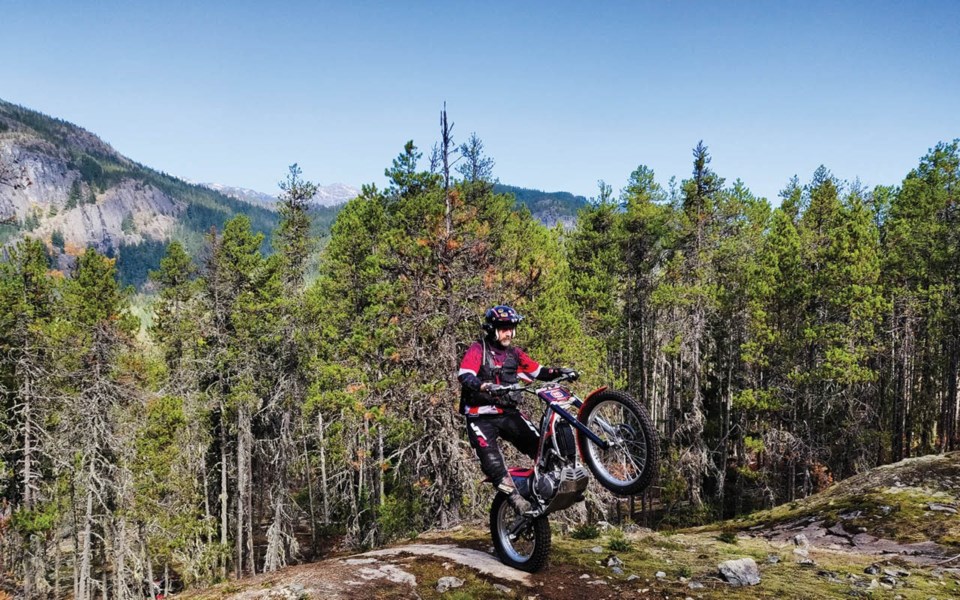I'm seldom this nervous trying out new sports, but when it involves motors, I tend to tense up a bit. I played on dirt bikes a bit as a kid, but this is my first time riding a trials motorbike (a seat-less, smaller, lighter, shorter-travel version of a motocross bike).
My guide today is Bill Cowan, a Sea to Sky resident for most of 25 years and trials rider for roughly half of that time. He's a career mechanic, a trail builder and sits on the board of the Pemberton Valley Trail Association (PVTA). Bill was nice enough to lend me one of his older bikes—a 270cc '02 Beta Rev-3—on the condition that if I break it, I buy it (adding to the nervousness).
I start by putting around the gravel lot and getting a feel for the throttle, the hydraulic clutch and the brakes. I struggle a bit with modulating the rear brake with my right foot, but I'm cornering the bike at low speed and feel like I have decent balance. Cowan leads me around a few corners up a decommissioned fire road and signals me to follow him back down the single track. I'm more confident going downhill and I ambitiously follow Cowan down a small rock slab. The resulting bump flicks my wrist downwards giving the engine a burst of throttle buzzing loudly as I'm thrown from the bike.
"That's why you need to keep your finger on that clutch," explains Cowan as he helps me pick the bike back up, checking it for damage as he does so. "The motor can whine as loud as it wants, but if you have the clutch in, you won't go anywhere."
After my gaffe, Cowan leads me up my first rock slab climb. It's not steep, but I'm proud of my effort nonetheless. He asks me if I have time to head to the top of Sticks and Stones (the area we are riding adjacent to Highway 99 between Whistler and Pemberton), I reply with a slight air of hesitation: "Bill, if you trust me with your bike, then sure, let's go."
Cowan isn't here to instruct, he's out for his 106th ride of the season today and won't be going home without his fill. Throughout the climb, he gestures toward the easiest way up while his bike dances up the advanced routes with ease.
I'm still struggling with topping out on the steeper climbs, Cowan still pulling over to spot me and ready to grab onto the bike if I don't quite make it up. I remember his tip from an earlier about moving the hips forward. Now with some confidence on the mechanical operation of the bike, I shift my weight forward over the front wheel. Suddenly I'm able to steer the bike when climbing gradients of rock I was floundering on previously.
Over a burger and beer on the Mile One patio in Pemberton, Cowan gives me a run down on the trials moto movement in the Sea to Sky and the trail work these riders undertake for their own areas, as well as mountain-biking zones.
"We really want to be in the shadows," he explains. "We don't want to pop out and demand a whole bunch of stuff (from the other user groups), because we could just be shut out completely."
While still quite niche, this moto discipline has grown significantly over the last 20 years (members of the 99 Trials Facebook group estimate around 60 to 100 active riders in the Sea to Sky). Trials riders are vastly outnumbered by mountain bikers and hikers and are often greeted icily, even when those other user groups are walking or pedalling on legacy trials trails.
"A lot of people in Whistler know what trials (riding) is and what we do, it's Joe Public who is new to mountain biking, or is up hiking from out of town that gets offended," says Andrew DeBoer, Director of Northern Relations for 99 Trials Association. "They come with their expectations and end up on trails that trials enthusiasts built and maintain. When they get passed by a trials bike they stare at us with disdain or contempt. How can we not get frustrated with that reaction?"
Cowan will even spend time clearing mountain bike trails snow and deadfall in the spring as a token of goodwill, and to get a few early season rides in.
"The first 20 rides of the season are chainsaw days," says Cowan. "We start (clearing) the mountain bike trails, then do the big push to open up our own trails. We'll often ride at night (with lights) to just avoid the trail conflicts."
With more than a handful of trials trails expropriated by mountain bikers in Whistler (think Ride Don't Slide, Jaws/Rainbow's End and more recently, Up, Up, and Away), trials riders are now building their trails to avoid a mountain bike incursion. They do this by choosing terrain that disrupts the downhill flow that mountain bikers enjoy (which is still fun and challenging for trials riders) and avoiding zones accessible via shuttle or determined pedalling.
When encountering younger trials riders on trail or in the car park, Cowan makes an effort to engage in conversation and serve as a role model.
"I'm not a social guy, but if nobody wants to do it I guess I'll do it," he says. "Someone has to keep an eye out for the yahoos who don't give a shit, otherwise we'd probably have been shut out of the whole process by now."
Vince Shuley has resigned himself that a new sport is on the horizon. For questions, comments or suggestions for The Outsider email vince@vinceshuley.com or Instagram @whis_vince.




